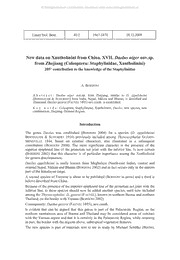
New data on Xantholinini from China. XVII. Daolus niger nov.sp. from Zhejiang (Coleoptera: Staphylinidae, Xantholinini) 205° contribution to the knowledge of the Staphylinidae PDF
Preview New data on Xantholinini from China. XVII. Daolus niger nov.sp. from Zhejiang (Coleoptera: Staphylinidae, Xantholinini) 205° contribution to the knowledge of the Staphylinidae
© Biologiezentrum Linz/Austria; download unter www.biologiezentrum.at Linzer biol. Beitr. 41/2 1867-1870 18.12.2009 New data on Xantholinini from China. XVII. Daolus niger nov.sp. from Zhejiang (Coleoptera: Staphylinidae, Xantholinini) 205° contribution to the knowledge of the Staphylinidae A. BORDONI Abstract: Daolus niger nov.sp. from Zhejiang, similar to D. eppelsheimi (BERNHAUER & SCHUBERT) from India, Nepal, Sikkim and Bhutan, is described and illustrated. Daolus gestroi (FAUVEL 1895) nov.comb. is established. K ey w ords: Coleoptera, Staphylinidae, Xantholinini, Daolus, new species, new combination, Zhejiang, Oriental Region. Introduction The genus Daolus was established (BORDONI 2004) for a species (D. eppelsheimi BERNHAUER & SCHUBERT 1914) previously included among Thyreocephalus GUÉRIN- MÉNEVILLE 1844, based on external characters, also illustrated in a subsequent contribution (BORDONI 2008). The more significant character is the presence of the superior epipleural line of the pronotum not joint with the inferior line. Is now certain (BORDONI 2002) that this character is of particular importance among the Xantholinini for genera discrimination. Daolus eppelsheimi is really known from Meghalaya (North-east India), central and oriental Nepal, Sikkim and Bhutan (BORDONI 2002) and in fact occurs only in the eastern part of the himalayan range. A second species of Formosa is about to be published (BORDONI in press) and a third is belove described from China. Because of the presence of the superior epipleural line of the pronotum not joint with the inferior line, to these species should now be added another species, until now included among the Thyreocephalus: D. gestroi (FAUVEL), known in northern Burma and northern Thailand, on the border with Yunnan (BORDONI 2002). Consequently: Daolus gestroi (FAUVEL 1895), nov.comb. Is evident that can be argued that this genus is part of the Palaearctic Region, as the northern montainous area of Burma and Thailand may be considered areas of conctact with the Yunnan region and that it is certainly in the Palaearctic Region, while retaining in part, the border with the regions above, subtropical vegetation features. The new species is part of materials sent to me in study by Michael Schülke (Berlin), © Biologiezentrum Linz/Austria; download unter www.biologiezentrum.at 1868 collectd in China in 2007, already subject of a study in a previous contribution (BORDONI in press). Material Daolus niger nov.sp. (Figs 1-4) H olotype (cid:1): China, Zhejiang, Tianmu Shan N. R., way to peak of immortals, 30.20N, 119.25E, 1100-1200 m, M. Schülke leg. 15.VI.2007 (coll. Schülke, Berlin); paratypus (cid:2): China, Zhejiang, W Tianmu Shan, N. R., path to peak of immortals (Blind allay), 30.20N., 119,25E, 1100-1200 m (coll. Bordoni, Firenze). Descr i pt i on: Body 16 mm long; length from the anterior margin of the head to the posterior margin of elytra: 8 mm. Body shiny, black; genital segment reddish; antennae and legs brown blackish. Head backwards dilated, with rounded sides and strictly rounded posterior angles. Eyes small and almost flat. Labrum as in fig. 1. Surface of the head with sparce and very fine micropunctation and with some small punctures, one under the insertion of the antennae, one at the end of the ocular grooves, two under the eyes, two near the posterior angles, some others on the posterior half of the head. Pronotum longer and narrower that head, with one puncture near the anterior angles. Elytra narrow, shorter and narrower than pronotum, with distict humeri. Surface with 2-3 series of fine punctures near the suture, one median series of more distinct and large punctures. Abdomen without microsculpture, with distinct, dense punctures, especially on the lateral portion. Tergite and sternite of the male genital segment as in figs. 2-3. Aedeagus (fig. 4) big (3.55 mm long), with symmertical and short parameres; internal sac short, tubular, with some lateral scales. Di st r i b u t i o n : It is known to me only from the type locality. E t y mol ogy : The specific epithet is based on the Latin niger- a- um (blach). No t es: This species differs from D. eppelsheimi by body size, coloration, punctation, labrum and aedeagus. Acknowledements I wish to thank my colleague Michael Schülke for the loan of the material which this study is based on. Zusammenfassung Daolus niger nov.sp. von Zhejiang, welche D. eppelsheimi (BERNHAUER & SCHUBERT) aus Indien, Nepal, Sikkim und Bhutan ähnlich ist, wird beschrieben und illustriert. Die Neukombination von Daolus gestroi (FAUVEL 1895) wird festgelegt. © Biologiezentrum Linz/Austria; download unter www.biologiezentrum.at 1869 References BORDONI A. (2002): Xantholinini della Regione Orientale (Coleoptera: Staphylinidae). Classificazione, filogenesi e revisione tassonomica. — Memorie del Museo regionale di Scienze naturali, Torino 33, 998 pp. BORDONI A. (2004): Nuovi dati per la conoscenza degli Xantholinini della Regione Orientale. V. Daolus hromadkai gen.n., sp.n. del Nepal e Thyreocephalus perakensis n.sp. della Malesia (Coleoptera Staphylinidae). — Entomologica, Bari 38: 83-89. BORDONI A. (2008): Sulla validità del genere Daolus BORDONI, 2004 e sulla sinonimia tra Thyreocephalus eppelsheimi BERNHAUER & SCHUBERT, 1914 e Daolus hromadkai BORDONI, 2004 (Coleoptera, Staphylinidae, Xantholinini). — Onychium, Firenze 6: 60- 61. Author's address: Dr. Arnaldo BORDONI Museo Zoologico "La Specola" Sezione del Museo di Storia naturale dell'Università via Romana 17, 50125 Firenze, Italy E-mail: [email protected] © Biologiezentrum Linz/Austria; download unter www.biologiezentrum.at 1870 1 2 3 4 Figs 1-4: Daolus niger nov.sp: (1) labrum; (2) tergite of the male genital segment; (3) sternite of the same; (4) aedeagus (scale: 0.1 mm).
